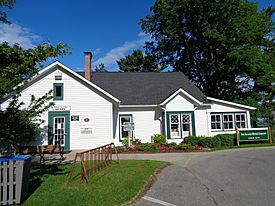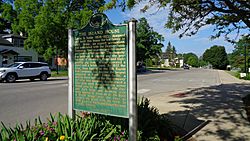The Island House facts for kids
Quick facts for kids The Island House |
|
|---|---|
 |
|
| Location | 300 Isle of Pines Drive Elk Rapids, Michigan |
| Built | 1865 (160 years ago) |
| Designated | April 24, 1979 |
| Lua error in Module:Location_map at line 420: attempt to index field 'wikibase' (a nil value). | |
The Island House is a very old building in Elk Rapids, Michigan. People also call it the Edwin Noble House or the Elk Rapids Island House. It was built in 1865 by Edwin S. Noble as his family home.
This special house became a Michigan State Historic Site on April 24, 1979. This means it's an important place in Michigan's history. Since 1949, the Island House has been used as a public library. It is part of the Elk Rapids District Library.
Contents
Discovering the Island House Location
The Island House sits on an island right where the Elk River meets Grand Traverse Bay. Grand Traverse Bay is a part of the much larger Lake Michigan. This island doesn't have an official name.
The Elk River is quite short, only about 1.5 miles (2.4 km) long. It flows from Elk Lake. Before, the river had many fast-moving parts called rapids. The water dropped about seven feet (2.1 m) in this short distance.
How the Island Changed Over Time
The island is about four acres (1.6 hectares) in size. Its highest point is about 25 feet (7.6 m) above the water. Edwin Noble, who built the house, made big changes to the island. He added clay and rich soil. He also planted many trees. Because of all the trees, people started calling it "The Isle of Pines."
Noble also built a small bridge to connect the island to the mainland. The fast rapids around the island disappeared in 1917. This happened when the Elk Rapids Hydroelectric Dam was built. This dam is still working today.
Now, the Village of Elk Rapids owns the island. It's open to everyone as part of the Elk Rapids Harbor. You can find paved roads, bridges, a place to launch boats, and many docks there. There's also a big parking lot and park areas for people to enjoy.
The Island House Story
In 1855, the Noble family moved to Elk Rapids. Henry Noble and his business partner, Wirt Dexter, started buying a lot of land there. Their company, the Noble-Dexter Company, became the biggest employer in Elk Rapids. They mainly made pig iron, which is a type of iron.
The company also grew into other areas. They worked with lumber, made chemicals, and produced flour. By 1882, the company changed its name to the Elk Rapids Iron Company. It became one of the largest iron companies in Michigan.
Building a Home on the Island
In 1865, Henry's older brother, Edwin Noble, moved to Elk Rapids. He started working for the company and later gained some control over it. Henry Noble and Wirt Dexter owned the small island. Edwin wanted to build his home in this perfect spot.
Edwin Noble built the house in 1865. As his family grew and he became wealthier, he added more rooms. The house eventually had four bedrooms, a living room (parlor), a dining room, and two bathrooms. It was one of the most expensive and fancy homes in Elk Rapids. People even called the island the "Island of Nobility." This was because it hosted many big parties and fun events.
The fast-moving rapids around the island were great for powering the company's sawmills. The main blast furnace, which made iron, was also nearby.
New Owners and a New Purpose
In 1892, Edwin Noble had a serious boating accident. He was badly hurt and could no longer work. He lost his control of the Elk Rapids Iron Company. Because of money problems, he sold the house in 1903. The new owners of the company, from Grand Rapids, bought it.
The house then became a vacation home for the company's business friends. Later, the nearby forests ran out of trees. Also, better ways to make iron were discovered. So, the Elk Rapids Iron Company closed down around 1918.
In 1926, the house became the property of Wirt Dexter's wife, Josephine. Then it went to their daughter, Katharine McCormick. She never actually lived in the house. In 1948, Katharine gave the island and the house to the Village of Elk Rapids. After that, local people could rent it for vacations, meetings, and small parties.
The Island House Library
In 1949, the Island House was turned into a library. It became part of the Elk Rapids District Library system. This library serves the people living in Elk Rapids village. It also helps those in the nearby areas of Elk Rapids, Milton, and Torch Lake townships.
On April 24, 1979, the Island House was chosen as a Michigan State Historic Site. A special plaque was placed on the building. A historic marker was also put up nearby on River Street in 1989. The old Elk Rapids Iron Company, which is now just a small ruin of its original furnace, was made a historic site earlier in 1973.
The Island House is one of four historic sites in Antrim County, Michigan. The others include the Elk Rapids Iron Company ruins, the Elk Rapids Township Hall, and the Hughes House. The Township Hall and Hughes House are also on the National Register of Historic Places. However, the Island House is only listed at the state level.
Plans for Library Expansion
In 2014, the library received a large gift of $400,000 from a local resident, Charles Heffer. He wanted the money to be used to make the library better and bigger. This big donation started talks about updating and expanding the Island House Library.
In early 2017, the Elk Rapids District Library got permission to build a large addition. This plan included adding a second floor. It would almost double the size of the library. Some worried it might completely replace the old building. They also feared it would change the island's beautiful look. Even though the property is historic, state officials approved the plan.
Local people did not like the idea of changing the historic building. Protest signs saying "Preserve Our Island House and Property" started appearing. At a village meeting in November 2017, the council voted against the big expansion. They asked for a smaller plan instead. This would try to make both sides happy. People against the big changes worried that major alterations could make the property lose its historic status.
The library's director, Nannette Miller, supported the expansion. She saw it as a way to make the library bigger and more useful. Others who wanted the expansion believed the current library was too small for the community.
In September 2018, the village council approved a plan for a 6,300 square foot (583 m²) expansion. Many residents still had concerns. However, the Michigan State Historic Preservation Office approved the project. This approval helps make sure the property keeps its historic status. The project will change the library a lot. But it will also include many repairs to the historical parts of the building.
The project will be paid for by donations. As of February 2019, $1 million had been raised. Organizers need to collect $3.4 million more before building can start. The total cost of the expansion is estimated to be $4.7 to $5.0 million. No public tax money will be used for this project. There is no exact date set for when construction will begin.


